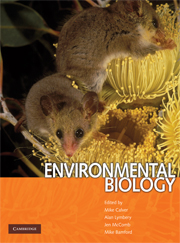Book contents
- Frontmatter
- Contents
- List of contributors
- Preface
- Acknowledgements
- Theme 1 What is environmental biology?
- Theme 2 The scientific method and the unifying theories of modern biology
- Theme 3 Applying scientific method – understanding biodiversity
- 8 Coping with cornucopia – classifying and naming biodiversity
- 9 Microscopic diversity – the prokaryotes and viruses
- 10 Mysterious diversity – the protists (including the fungi)
- 11 Plant diversity I – the greening of the land
- 12 Plant diversity II – the greening of the land
- 13 Life on the move I – introducing animal diversity
- 14 Life on the move II – the spineless majority
- 15 Life on the move III – vertebrates and other chordates
- Theme 4 Applying scientific method – biodiversity and the environment
- Theme 5 The future – applying scientific method to conserving biodiversity and restoring degraded environments
- Glossary
- Index
14 - Life on the move II – the spineless majority
from Theme 3 - Applying scientific method – understanding biodiversity
- Frontmatter
- Contents
- List of contributors
- Preface
- Acknowledgements
- Theme 1 What is environmental biology?
- Theme 2 The scientific method and the unifying theories of modern biology
- Theme 3 Applying scientific method – understanding biodiversity
- 8 Coping with cornucopia – classifying and naming biodiversity
- 9 Microscopic diversity – the prokaryotes and viruses
- 10 Mysterious diversity – the protists (including the fungi)
- 11 Plant diversity I – the greening of the land
- 12 Plant diversity II – the greening of the land
- 13 Life on the move I – introducing animal diversity
- 14 Life on the move II – the spineless majority
- 15 Life on the move III – vertebrates and other chordates
- Theme 4 Applying scientific method – biodiversity and the environment
- Theme 5 The future – applying scientific method to conserving biodiversity and restoring degraded environments
- Glossary
- Index
Summary
Invertebrates – out of sight, out of mind
Land and Water Australia's 2002 terrestrial biodiversity assessment painted a grim picture for Australia's terrestrial fauna. It was estimated that 27 species of mammals, 27 species or subspecies of birds, one reptile species and four frog species have become extinct in Australia since European settlement, with a further 253 species or subspecies currently threatened with extinction. Yet these figures, sobering as they are, are a massive underestimate of the extinction crisis facing Australia's wildlife. The terrestrial biodiversity assessment considered only vertebrates (animals with backbones). However, the 6000 described species of vertebrates make up only about 6% of described animal species in Australia compared to about 100000 described species of invertebrates (and there are at least 200000 invertebrates still to be described).
The lack of attention paid to the conservation of invertebrates is not because they are not endangered. The problem is lack of knowledge. In a scientific sense, we have much to learn about the taxonomy, biology, ecology and conservation status of invertebrates. Invertebrates are very often ignored or actively discouraged by the general public. However, they are critical components of ecosystems, providing integral links in the food chain as well as essential ecosystem services such as plant pollination, soil aeration, organic decomposition and pest control.
Chapter aims
In this chapter we introduce you to the main phyla of invertebrate animals. Each phylum has a common evolutionary history and common features that have evolved to cope with environmental challenges (Chapter 13).
Information
- Type
- Chapter
- Information
- Environmental Biology , pp. 304 - 334Publisher: Cambridge University PressPrint publication year: 2009
